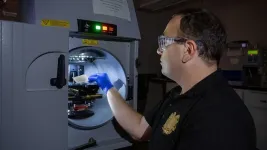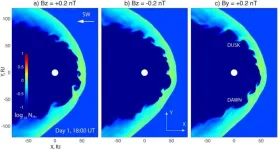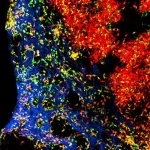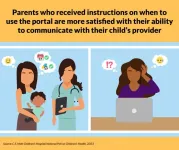(Press-News.org) University of Pittsburgh researchers have shown for the first time how Merkel cell polyomavirus (MCV), which causes an aggressive skin cancer called Merkel cell carcinoma, initiates DNA replication in host cells.
Published today in the journal PNAS, the study sheds light on the fundamental question of how viruses override their host cells’ carefully regulated DNA replicating system to make hundreds of new copies of themselves.
“Understanding how MCV replicates gives us really important clues about how this virus can cause cancer,” said co-senior author Patrick Moore, M.D., distinguished professor in the Pitt School of Medicine’s Department of Microbiology and Medical Genetics and UPMC Hillman Cancer Center. “It also provides insight into other cancer-causing viruses and why some viruses don’t cause cancer. In the future, this might help us develop new therapeutics or vaccines against cancers caused by infection.”
Moore and co-senior author Yuan Chang, M.D., distinguished professor in the Department of Pathology and UPMC Hillman Cancer Center first discovered MCV in 2008. According to Moore, most adults harbor this virus, which is usually harmless but occasionally causes Merkel cell carcinoma, a deadly form of skin cancer that is diagnosed in about 3,000 people in the U.S. each year.
In the new study, which was led by postdoctoral associate Li (James) Wan, Ph.D., the researchers teamed up with Bennett Van Houten, Ph.D., professor in Pitt’s Department of Pharmacology & Chemical Biology, and postdoctoral fellow Matthew Schaich, Ph.D., to study MCV replication in never-before-seen detail using an instrument called a C-trap and a technique called SMADNE.
“Until now, we’ve had to infer how viruses replicate from static images, which are essentially just a snapshot in time,” said Moore. “The C-trap allows us to watch proteins bind to a single molecule of DNA in real-time as little dots of light. It’s like watching a movie instead of looking at a photograph.”
During normal cell division, the first step of DNA replication involves proteins called helicases that form two sleeves around the DNA double helix. These sleeves push together to unzip the double-stranded DNA into single strands so that other proteins can bind and perform the next steps. This unzipping process requires cellular energy in the form of the molecule ATP.
“DNA replication is tightly controlled by the cell,” said Moore. “If any one of the 3 billion base pairs that make up our genome has a mutation, it can cause cancer or other diseases, so an enormous amount of energy is spent on checking for errors and making sure that conditions in the cell are correct for replication.”
Known as licensed DNA replication, this controlled process occurs only once each time a cell divides.
In contrast, when a virus hijacks a host cell’s DNA replication machinery, it replicates hundreds of times.
This “unlicensed” replication is not subject to the same quality control and is much more prone to errors. With MCV, certain mutations can cause the virus’s entire genetic code, or genome, to get inserted into its host’s genome, causing previously normal cells to undergo uninhibited growth and division to become cancerous. Moore and Chang’s team found that MCV’s version of helicase does not form sleeves around the DNA as they had expected. Instead, it directly pries apart the DNA molecule. The viral helicase can do this repeatedly without using ATP, enabling the virus to outcompete normal cellular replication.
According to Moore, this research could eventually lead to new antiviral therapies, not for MCV because it’s usually harmless, but for closely related viruses such as those known as JC and BK that are major problems for transplant patients or for other cancer-causing viruses.
In addition to MCV, six other human viruses are known to cause cancer, including human papillomavirus (HPV) that causes cervical and head-and neck cancer and Kaposi sarcoma herpesvirus — also discovered by Moore and Chang — which causes a type of cancer that forms in the lining of the blood and lymph vessels.
Going forward, the researchers plan to broaden their understanding of viral replication by studying some of these other cancer-causing viruses in comparison to MCV.
“Viruses are like tiny little robots, but they still have very complicated mechanisms that allow them to sense their environment and detect what’s happening in the host cell so they know when it’s most beneficial to go from a quiet, or latent, state to initiating replication,” said Moore. “Learning how they replicate is central for developing safe and effective antiviral medications or vaccines that target these proteins within a cancer cell.”
Additional authors on the study were Sabrina Toland, Lindsey R. Robinson-McCarthy, Ph.D., Nara Lee, Ph.D., Sarah R. Hengel, Ph.D., of UPMC or Pitt; Xiaochen Li, of UPMC and Tsinghua University; and Kara A. Bernstein, Ph.D., of the University of Pennsylvania.
This research was supported by the National Institutes of Health (R35CA197463, R01CA232604, R35ES031638, K99ES033738, R01ES031796 and R01ES030335, 2P30CA047904 and S10OD032158-01A1), the Hillman Postdoctoral Fellowship for Innovative Cancer Research and the American Cancer Society Postdoctoral Fellowship.
##
END
How skin cancer virus outcompetes host cell replication
New study sheds light on the fundamental question of how viruses override their host cells' DNA replicating system
2023-07-17
ELSE PRESS RELEASES FROM THIS DATE:
All about the Benjamins: Researchers decipher the secrets of Benjamin Franklin’s paper money
2023-07-17
Benjamin Franklin may be best known as the creator of bifocals and the lightning rod, but a group of University of Notre Dame researchers suggest he should also be known for his innovative ways of making (literal) money.
During his career, Franklin printed nearly 2,500,000 money notes for the American Colonies using what the researchers have identified as highly original techniques, as reported in a study published this week in the Proceedings of the National Academy of Sciences.
The research team, led by Khachatur ...
Redlining linked to higher heart failure risk among Black adults in US
2023-07-17
Research Highlights:
An analysis of more than two million adults in the U.S. found that present day heart failure risk was higher among Black adults who lived in zip codes historically impacted by redlining compared to Black adults living in non-redlined areas.
Redlining did not have the same impact on heart failure risk among white adults living in historically redlined zip codes.
Among Black adults living in historically redlined communities, approximately half of the excess risk of heart failure appeared to be explained by higher levels of socioeconomic distress.
Embargoed until 1 p.m. CT/2 p.m. ET Monday, July 17, ...
Racial disparities discovered in patients with cardiac devices
2023-07-17
Black patients with implantable cardioverter defibrillators (ICDs) have a significantly higher burden of disease than white patients with the same device, according to a new study from University of Rochester Medical Center (URMC) cardiology researchers. Analyzing data from clinical trials conducted over a 20-year period by the Clinical Cardiovascular Research Center (CCRC) at URMC, investigators concluded that not only did Black patients with ICDs tend to be significantly younger than white patients, but they also had a higher ...
SwRI team identifies giant swirling waves at the edge of Jupiter’s magnetosphere
2023-07-17
SAN ANTONIO — July 17, 2023 —A team led by Southwest Research Institute (SwRI) and The University of Texas at San Antonio (UTSA) has found that NASA’s Juno spacecraft orbiting Jupiter frequently encounters giant swirling waves at the boundary between the solar wind and Jupiter’s magnetosphere. The waves are an important process for transferring energy and mass from the solar wind, a stream of charged particles emitted by the Sun, to planetary space environments.
Jake Montgomery, a doctoral student in the joint space physics program ...
Immune cells in single file
2023-07-17
The cells of the immune system circulate mainly in the blood and migrate into the body's tissues after an inflammation. Some types of immune cells, however, are permanently located in the tissues, where they come together to form three-dimensional networks.
How do these networks form and how are they maintained? For the long-lived macrophages (phagocytes), the answer is already known: They settle in so-called niches. These are environments of connective tissue cells that supply the macrophages with nutrients and keep them ...
New research shows babies’ immunological weak spot and strength
2023-07-17
NEW YORK, NY--A pair of new studies led by researchers at Columbia University explains why babies get so many common respiratory infections and identifies a specialized cluster of immune cells found only in babies that help them better cope with new pathogens.
“We know little about how the immune system develops throughout life, and most of what we know about immune system development in children comes from animal studies,” says Donna Farber, PhD, an expert in immune system development at Columbia University ...
National Poll: Less than half of parents utilize patient portal benefits for their children
2023-07-17
ANN ARBOR, Mich. – For many busy families, online access to a child’s health provider for medical advice, health records or prescription refills is likely a convenient option.
Yet, only 43% of parents have set their child up for a patient portal – an online tool allowing communication between patients and medical providers – and others may not be optimizing portal use, suggests the University of Michigan Health C.S. Mott Children’s Hospital National Poll on Children’s Health.
“Patient portals offer a wide range of benefits, including decreasing unnecessary hassles for providers and patients and improving access to both the medical ...
The missing Americans: Unprecedented US mortality far exceeds other wealthy nations
2023-07-17
FOR IMMEDIATE RELEASE
Monday, July 17, 2023
Contact:
Jillian McKoy, jpmckoy@bu.edu
Michael Saunders, msaunder@bu.edu
##
The Missing Americans: Unprecedented US Mortality Far Exceeds Other Wealthy Nations
A new study found that more than one million US deaths a year—including many young and working-age adults—could be avoided if the US had mortality rates similar to its peer nations.
In 2021, 1.1 million deaths would have been averted ...
Addressing the future challenges of global surface water quality
2023-07-17
As the world's population continues to grow, ensuring access to clean and safe water has become an increasingly important concern, yet little is known about how surface water quality will change in the future. Recent scientific research has shed light on the potential challenges that surface water quality may face in the coming years, particularly in Sub-Saharan Africa. “While surface water quality is projected to improve in most developed countries, there is an important caveat: the outlook for the poorest nations is bleak”.
A recent study, published in Nature Water, has projected an increase in surface water pollution in Sub-Saharan Africa. These findings ...
Study finds how to reduce risk of kids playing with a found gun
2023-07-17
COLUMBUS, Ohio – In a lab at The Ohio State University masquerading as a playroom, pairs of kids ages 8 to 12 participating in a study found a variety of toys and games to play with – as well as a mysterious file cabinet.
Inside one of the drawers of the unlocked cabinet were two disabled 9-mm handguns.
As they played in the room, nearly all the children eventually found the guns. But some kids in the study were much more likely to tell an adult they found a gun, less likely to touch the gun, and were less reckless if they did touch it – and they were the kids who had watched a one-minute gun safety video a week earlier.
The study may be the ...
LAST 30 PRESS RELEASES:
University of Oklahoma researcher awarded funding to pursue AI-powered material design
Exploring how the visual system recovers following injury
Support for parents with infants at pediatric check-ups leads to better reading and math skills in elementary school
Kids’ behavioral health is a growing share of family health costs
Day & night: Cancer disrupts the brain’s natural rhythm
COVID-19 vaccination significantly reduces risk to pregnant women and baby
The role of vaccination in maternal and perinatal outcomes associated with COVID-19 in pregnancy
Mayo Clinic smartwatch system helps parents shorten and defuse children's severe tantrums early
Behavioral health spending spikes to 40% of all children’s health expenditures, nearly doubling in a decade
Digital cognitive behavioral treatment for generalized anxiety disorder
Expenditures for pediatric behavioral health care over time and estimated family financial burden
Air conditioning in nursing homes and mortality during extreme heat
The Alps to lose a record number of glaciers in the next decade
What makes a good proton conductor?
New science reporting guide published for journalists in Bulgaria
New international study reveals major survival gaps among children with cancer
New science reporting guide published for journalists in Turkey
Scientists develop a smarter mRNA therapy that knows which cells to target
Neuroanatomy-informed brain–machine hybrid intelligence for robust acoustic target detection
Eight SwRI hydrogen projects funded by ENERGYWERX
The Lundquist Institute and its start-up company Vitalex Biosciences Announces Strategic Advancement of Second-Generation fungal Vaccine VXV-01 through Phase 1 Trials under $40 Million Competitive Con
Fine particles in pollution are associated with early signs of autoimmune disease
Review article | Towards a Global Ground-Based Earth Observatory (GGBEO): Leveraging existing systems and networks
Penn and UMich create world’s smallest programmable, autonomous robots
Cleveland researchers launch first major study to address ‘hidden performance killer’ in athletes
To connect across politics, try saying what you oppose
Modulating key interaction prevents virus from entering cells
Project explores barriers to NHS career progression facing international medical graduates
Jeonbuk National University researchers explore the impact of different seasonings on the flavor perception of Doenjang soup
Two Keck Medicine of USC Hospitals named Leapfrog Top Teaching Hospitals
[Press-News.org] How skin cancer virus outcompetes host cell replicationNew study sheds light on the fundamental question of how viruses override their host cells' DNA replicating system



